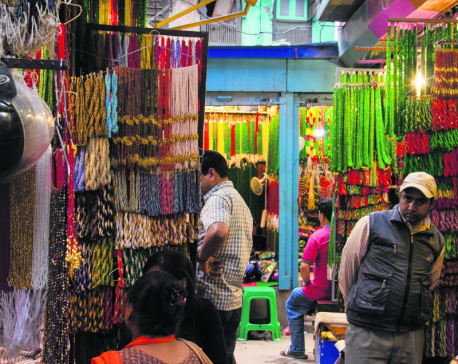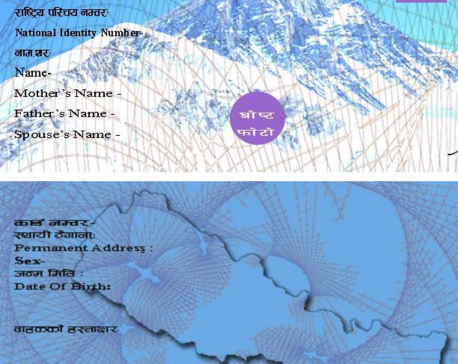
OR
SIDELINES

There is nothing Maithil or Madhesi about the Kurta-Suruwal ensemble the Premier-duo donned, but it blended so well with the Mughal-Rajput architecture in the background
It was a period of journalistic din last week. There was the commotion over formation of a government in the resource-rich Karnataka. Prelude to the royal-nuptial circus in London had excited media persons world over. The merger and acquisition of Marxist-Leninist and Maoist parties to form one single platform of Underlined Communists was too big news to not hog the local limelight.
When the assumed chieftain of the constitutionally-created Khas-Arya clan Khadga Prasad Sharma Oli made an offer that his fellow caste-mate Pushpa Kamal Dahal couldn’t refuse, there was little that lesser advocates of Madhesi, Janjati, Muslim and women rights in the ranks of erstwhile revolutionary party could do. In keeping with its character, the Bahun media correctly celebrated the consolidation of its clannish hegemony as a success story.
Amidst the clamor for the attention of the audience, very few journalists were able to catch their breath and notice that the holy month of Ramadan had begun without much fanfare. The print media in Kathmandu missed the story of passing away of one of the most innovative journalists of the late-twentieth century in the English language. I know, the connection may appear tenuous, but the commencement of Ramadan and death of Tom Wolfe (March 2, 1930 – May 14, 2018) reminded me of a short exchange of texts that I had had a few days back with ace journalist Subina Shrestha.
For anyone who was following the international media during the Gorkha Earthquakes and the Third Madhes Uprising, Subina needs no introduction. She is one of those few conscientious journalists in Nepal that care to report from the thick of the action incorporating voices of the street rather than offering megaphones to politicos and analysts that prefer to pontificate from the comfort of their couch in front of a television screen.
When the Indian Prime Minister Narendra Modi was in Janakpur, Subina was there to catch the carnivalesque atmosphere. She heard from someone there that Muslim masons had actually built one of the holiest of places of worship for Ramanandi sect of Vaishnav stream in Hinduism. Perhaps more to dig a little deeper than to confirm the information, she texted me to inquire whether what she had heard was true.
Building faith
For a long time, most masons in the Hindu heartland of the Ganga plains have been Dalits and Janjatis. During the early years of the long Islamic rule in northern India, many of them worked under master craftsmen called from Persia to design and erect what would later evolve into Mughal-Rajput style of architecture with their fabulous domes and commanding spires.
In course of time, some apprentices of émigré designers and builders themselves emerged as master craftsmen. Many of them embraced Islam for various reasons. So much so that Muslim Rajmistris—royal masons—eclipsed the profession of Vishwakarma Vastukars that had been building Shikhara temples before the emergence of the new breed of craftsmen.
Like most principalities of the era, the Bundela House of Orchha at Tikamgarh alternated between competition and cooperation with Mughal or British overlords. In order to maintain their claim upon heavenly mandate, Hindu chieftains took pride in building palatial temples. Before commissioning the Janaki Mandir upon the orders of her spiritual guru, Maharani Vrishbhan Kumari had already got the Kanak Bhavan Temple built at Ayodhya. It is quite likely that the same set of Rajmistris were brought from Faizabad to Janakpur. There is little doubt that most of those Rajmistris were Muslims.
When I told Subina that the Maharani that had commissioned the temple had also asked her managers to pay for a simple mosque just behind the shrine so that Rajmistris could offer their Friday prayers in group not too far from their workplace, her first question was, “Where can I get references?” It had never occurred to me that what my family had known to be true would someday require references!
Back to the apostle of New Journalism Tom Wolfe who had said about television journalists that they were not reporters but researchers and had added in a rather dismissive tone, “…that’s really all they are!” The real story is often lost in an obsession with “objective” concerns for specificity and veracity. Perhaps that’s why he had also pointed out, “The basic reporting unit is no longer the datum, the piece of information, but the scene, since most of the sophisticated strategies of prose depend upon scenes.”
That’s the angle that was completely missing from Janakpur-datelined stories. In their attempt to be objective, even print reporters had junked their feature writing skills. Nobody was telling truthful tales. Reporters were too busy streaming what they considered to be facts.
Ephemeral trifles
The mosque behind the temple remained a tiled-roof structure till the early-1960s when some Hindus of the Dashrath Talau area also donated for the construction of a small brick structure. When followers of the faith became richer, they went for a more elaborate edifice.
During early years of Panchayat, a few Hindu zealots had attempted to acquire the Muslim property in the name of extending and beautifying the temple complex, but the-then Mahanth had restrained them in no uncertain terms. Perhaps the Anchaladhis that commissioned the monstrosity called Bibah Mandal in faux ‘Nepali Estyle’ with tiered pagoda roof was the last one to attempt a relocation of the mosque. That it stands intact has as much to do with traditions of Vaishnavism, which teaches its adherents to rise above caste and sectarian differences, as the tenacity of Muslims.
Another trivia that could have added color to contents of the visit was the choice of dress of two presumptive strongmen. Sartorial social engineering is an important weapon in the arsenal of authoritarian leaders. King Mahendra decreed that everyone wear Labeda-Suruwal and Topi not just to make them look more nationalistic but also to force them realize that they were mere subjects of his whims.
It’s true that there is nothing Maithil or Madhesi about the Kurta-Suruwal ensemble that the Premier-duo donned, but there is little doubt that it blended so well with the Mughal-Rajput architecture in the background. The collarless male Kurta probably emerged in hot and humid wetlands of Bengal. The Suruwal is actually Chusta (tight) developed out of Pathan and Punjabi loose pants that were unsuitable for horse-riding and needed additional breeches below knees.
The dress that designers of Premier Oli came up with may have been chosen for aesthetics, but the selection of headgear was a sheer stroke of genius. It was so full of meaning that it made Premier Modi beam with joy.
In the Hindu hierarchy of headgears in Mithila, the austere Paag is mainly for pundits of Brahmans and Kayasthas but now-a-days learned people of other castes can also have a claim upon it. Pagadi is preferred by the landed gentry of Rajputs and Bhumihars. The quality and length of Muretha cloth often showed the status of Mukhiyas in what has come to be called Backward Castes. Lower down the hierarchy, plebeians had to be satisfied with tying a Pheta upon their heads with what was called Angochha in formal Maithili but also Gamchha in the colloquial language.
A Mukut—the crown—was reserved for deities and their earthly incarnations in the form of reigning sovereigns. Made to feel like king on the day of marriage, the bridegroom in Bihar and Bengal wore a Maud upon his head, which was an imitation crown made of flimsy materials.
The Vaishyas, no matter how rich they were, could never claim to be Manyabar and wear a Paag. Even when wealthy, their status was lower than Pagadi-wearing Manyajans of feudal families. The Vaishya Mahajans considered Murethas of Mukhiyas and Phetas of everyone else below their status. That’s where Shirmaur, the headgear of tribal chieftains in central and western India, came handy. It became a symbol of power for Vaishya Mahajans and Mahanths of some Hindu sects. Perhaps Premier Oli embraced it as a sign of prosperity politics.
After HD Deve Gauda, Premier Modi—a Vaishya by birth—is only the second person from what is now called the Other Backward Castes to rise to the seat of head of government in New Delhi. He once refused to wear the skull cap for the fear of antagonizing his Hindutva support base. Indian elections are scheduled for next year. He may not have any faith in the caste system, but the former Chaiwala knew the symbolic value of Shirmour in front of a Hindu shrine in a city dominated by Vaishyas.
You May Like This

The historical significance of Pote Bazaar
Pote, exclusively considered traditional ‘shauvagya chinna’ among Hindu women, was never a part of mainstream Hindu fashion, rather an adaptation... Read More...

Chelsea's Conte plays down significance of United clash
LONDON, April 15: Chelsea manager Antonio Conte refused to give extra significance to Sunday's Premier League clash at Manchester United, saying... Read More...

NIDMC begins consultation on biometric ID's significance
KATHMANDU, Sept 28: Even as National ID Management Center expedites efforts to complete technical and structural set up for issuing biometric... Read More...







Just In
- Govt appoints 77 Liaison Officers for mountain climbing management for spring season
- EC decides to permit public vehicles to operate freely on day of by-election
- Fugitive arrested after 26 years
- Indian Potash Ltd secures contract to bring 30,000 tons of urea within 107 days
- CAN adds four players to squad for T20 series against West Indies 'A'
- ‘Precast' technology introduced in the construction of bridges along Muglin-Pokhara road
- Leopard attack injures young man in Kanchanpur
- SC rejects writ petition filed against Home Minister Lamichhane













Leave A Comment